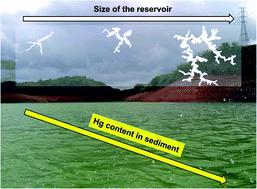当前位置:
X-MOL 学术
›
Environ. Sci.: Processes Impacts
›
论文详情
Our official English website, www.x-mol.net, welcomes your
feedback! (Note: you will need to create a separate account there.)
Insights into the factors influencing mercury concentrations in tropical reservoir sediments
Environmental Science: Processes & Impacts ( IF 4.3 ) Pub Date : 2021-09-08 , DOI: 10.1039/d1em00156f Carluvy Baptista-Salazar 1 , Gabrielle R Quadra 2 , Anna Sobek 1 , Sofi Jonsson 1
Environmental Science: Processes & Impacts ( IF 4.3 ) Pub Date : 2021-09-08 , DOI: 10.1039/d1em00156f Carluvy Baptista-Salazar 1 , Gabrielle R Quadra 2 , Anna Sobek 1 , Sofi Jonsson 1
Affiliation

|
Thousands of dams are currently under construction or planned worldwide to meet the growing need for electricity. The creation of reservoirs could, however, lead to conditions that promote the accumulation of mercury (Hg) in surface sediments and the subsequent production of methylmercury (MeHg). Once produced, MeHg can bioaccumulate to harmful levels in organisms. It is unclear to what extent variations in physical features and biogeochemical factors of the reservoir impact Hg accumulation. The objective of this study was to identify key drivers of the accumulation of total Hg (THg) in tropical reservoir sediments. The concentration of THg in all analyzed depth intervals of 22 sediment cores from the five contrasting reservoirs investigated ranged from 16 to 310 ng g−1 (n = 212, in the different sediment cores, the maximum depth varied from 18 to 96 cm). Our study suggests reservoir size to be an important parameter determining the concentration of THg accumulating in tropical reservoir sediments, with THg ranging up to 50 ng g−1 in reservoirs with an area exceeding 400 km2 and from 100 to 200 ng g−1 in reservoirs with an area less than 80 km2. In addition to the reservoir size, the role of land use, nutrient loading, biome and sediment properties (e.g., organic carbon content) was tested as potential drivers of THg levels. The principal component analysis conducted suggested THg to be related to the properties of the watershed (high degree of forest cover and low degree of agricultural land use), size and age of the reservoir, water residence time and the levels of nutrients in the reservoir. A direct correlation between THg and tested variables was, however, only observed with the area of the reservoir.
中文翻译:

深入了解影响热带水库沉积物中汞浓度的因素
目前,全球有数千座水坝正在建设或规划中,以满足日益增长的电力需求。然而,水库的形成可能会导致促进汞(Hg)在表层沉积物中积累以及随后产生甲基汞(MeHg)的条件。甲基汞一旦产生,就会在生物体内累积至有害水平。目前尚不清楚储层物理特征和生物地球化学因素的变化在多大程度上影响汞积累。本研究的目的是确定热带水库沉积物中总汞 (THg) 积累的关键驱动因素。所调查的五个对比储层的 22 个沉积物岩心的所有分析深度区间中 THg 的浓度范围为 16 至 310 ng g -1 ( n = 212,在不同的沉积物岩心中,最大深度从 18 至 96 cm 不等)。我们的研究表明,水库规模是决定热带水库沉积物中 THg 浓度的重要参数,面积超过 400 km 2 的水库中 THg 高达 50 ng g -1 ,面积超过 400 km 2 的水库中 THg 高达 100 至 200 ng g -1 。面积80平方公里以下的水库2 。除了水库规模之外,土地利用、养分负荷、生物群落和沉积物特性(例如有机碳含量)的作用也被测试为THg水平的潜在驱动因素。 主成分分析表明,THg 与流域性质(森林覆盖程度高、农业用地利用程度低)、水库规模和年龄、水体停留时间和水库养分水平有关。然而,THg 和测试变量之间的直接相关性仅在储层面积上观察到。
更新日期:2021-09-15
中文翻译:

深入了解影响热带水库沉积物中汞浓度的因素
目前,全球有数千座水坝正在建设或规划中,以满足日益增长的电力需求。然而,水库的形成可能会导致促进汞(Hg)在表层沉积物中积累以及随后产生甲基汞(MeHg)的条件。甲基汞一旦产生,就会在生物体内累积至有害水平。目前尚不清楚储层物理特征和生物地球化学因素的变化在多大程度上影响汞积累。本研究的目的是确定热带水库沉积物中总汞 (THg) 积累的关键驱动因素。所调查的五个对比储层的 22 个沉积物岩心的所有分析深度区间中 THg 的浓度范围为 16 至 310 ng g -1 ( n = 212,在不同的沉积物岩心中,最大深度从 18 至 96 cm 不等)。我们的研究表明,水库规模是决定热带水库沉积物中 THg 浓度的重要参数,面积超过 400 km 2 的水库中 THg 高达 50 ng g -1 ,面积超过 400 km 2 的水库中 THg 高达 100 至 200 ng g -1 。面积80平方公里以下的水库2 。除了水库规模之外,土地利用、养分负荷、生物群落和沉积物特性(例如有机碳含量)的作用也被测试为THg水平的潜在驱动因素。 主成分分析表明,THg 与流域性质(森林覆盖程度高、农业用地利用程度低)、水库规模和年龄、水体停留时间和水库养分水平有关。然而,THg 和测试变量之间的直接相关性仅在储层面积上观察到。











































 京公网安备 11010802027423号
京公网安备 11010802027423号